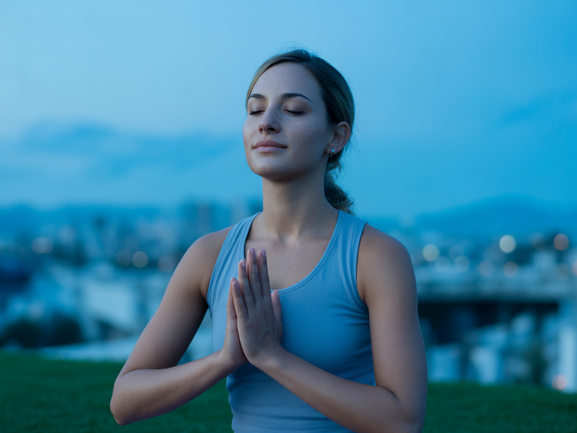How Yoga Philosophy Transforms Your Daily Energy & Vitality
Do you ever wonder why some people seem to radiate energy throughout the day while others struggle to keep their eyes open after lunch? The secret might not be in that extra cup of coffee, but rather in an ancient wisdom that’s been transforming lives for over 5,000 years: yoga philosophy.
<p>While many associate yoga with physical postures, the true power lies in its spiritual foundation – a comprehensive system designed to optimize your energy and connect you with your inner vitality. Today, we'll explore how these timeless principles can revolutionize your daily energy levels and overall well-being.</p>
<h2>Understanding Energy Through Yogic Eyes</h2>
<p>In yoga philosophy, energy isn't just physical stamina – it's <em>prana</em>, the life force that flows through everything. When this energy is blocked or scattered, we feel drained, anxious, and disconnected. However, when prana flows freely, we experience sustained vitality, mental clarity, and emotional balance.</p>
<p>Modern science is catching up to what yogis have known for millennia: our mental state directly impacts our physical energy. Studies show that <a href="https://www.ncbi.nlm.nih.gov/pmc/articles/PMC6971819/" rel="nofollow noindex" target="_blank">mindfulness practices can increase energy levels by up to 23%</a> within just eight weeks.</p>
<h2>The Eight Limbs: Your Blueprint for Sustainable Energy</h2>
<p>The <strong>Ashtanga system</strong> (eight limbs of yoga) provides a holistic approach to managing and amplifying your daily energy:</p>
<h3>1. Yamas & Niyamas: Energy Conservation Through Ethics</h3>
<p>These moral guidelines aren't just philosophical concepts – they're practical tools for preventing energy leaks. For instance, practicing <em>ahimsa</em> (non-violence) toward yourself means stopping that critical inner voice that drains your mental energy throughout the day.</p>
<h3>2. Asana: Physical Foundation for Energetic Flow</h3>
<p>While physical postures are just one aspect, they create the bodily foundation necessary for energy circulation. Even 10 minutes of gentle movement can significantly boost your vitality.</p>
<h3>3. Pranayama: The Gateway to Infinite Energy</h3>
<p>Breath is the bridge between body and mind. Through conscious breathing techniques, you can instantly access more energy. Try this simple practice: inhale for 4 counts, hold for 4, exhale for 6. This activation of your parasympathetic nervous system immediately reduces energy-draining stress.</p>
<blockquote>
<p>"Breath is the link between mind and body. Master your breath, and you master your energy." - Ancient Yogic Wisdom</p>
</blockquote>
<h2>Practical Applications for Modern Life</h2>
<p>Let's bridge ancient wisdom with contemporary living. Here are three powerful techniques you can implement immediately:</p>
<h3>Morning Energy Ritual (5 minutes)</h3>
<ol>
<li><strong>Intention Setting</strong>: Begin each day by setting a clear intention (dharana principle)</li>
<li><strong>Breath Awareness</strong>: Take 10 conscious breaths to center yourself</li>
<li><strong>Gratitude Practice</strong>: Acknowledge three things you're grateful for</li>
</ol>
<h3>Midday Reset Technique</h3>
<p>When energy dips around 2 PM, instead of reaching for caffeine, try the "Three-Breath Reset":</p>
<ul>
<li>Step away from your workspace</li>
<li>Take three deep, conscious breaths</li>
<li>Set a positive intention for the remainder of your day</li>
</ul>
<h3>Evening Wind-Down Practice</h3>
<p>Prepare for restorative sleep with gentle reflection on your day, releasing what no longer serves you, and setting intentions for tomorrow.</p>
<p>These practices align perfectly with <a href="https://vitalizen.app/#about">Vitalizen's holistic approach</a> to wellness, combining ancient wisdom with modern convenience.</p>
<h2>The Science Behind Spiritual Energy</h2>
<p>Research demonstrates that regular meditation and mindfulness practices lead to:</p>
<ul>
<li>Increased cortisol regulation (reduced stress-related energy drain)</li>
<li>Improved sleep quality (better energy restoration)</li>
<li>Enhanced focus and concentration (more efficient energy use)</li>
<li>Greater emotional resilience (less energy spent on reactive patterns)</li>
</ul>
<p>Additionally, studies on <a href="https://pubmed.ncbi.nlm.nih.gov/29990470/" rel="nofollow noindex" target="_blank">yoga practitioners show increased GABA levels</a>, a neurotransmitter associated with relaxation and sustained energy.</p>
<h2>Building Your Personal Energy Practice</h2>
<p>Creating a sustainable spiritual practice doesn't require hours of meditation or complex rituals. Start small and build consistency:</p>
<h3>Week 1-2: Foundation</h3>
<p>Focus on breath awareness for 5 minutes daily and practice mindful transitions between activities.</p>
<h3>Week 3-4: Integration</h3>
<p>Add intention-setting to your morning routine and incorporate brief meditation breaks.</p>
<h3>Week 5+: Expansion</h3>
<p>Explore deeper philosophical concepts and consider joining a structured program for guidance.</p>
<p>If you're looking for a comprehensive platform to support this journey, <a href="https://vitalizen.app">Vitalizen.app</a> offers guided meditations, philosophy lessons, and practical tools designed specifically for busy modern lives.</p>
<section id="faq" itemscope itemtype="https://schema.org/FAQPage">
<h2>Frequently Asked Questions</h2>
How is yoga philosophy different from physical yoga practice?
While physical yoga (asanas) focuses on postures and flexibility, yoga philosophy encompasses the complete system of ethical guidelines, breath work, meditation, and spiritual principles. Philosophy provides the ‘why’ behind the practice and offers tools for mental and emotional transformation that go far beyond physical fitness.
Can I apply yoga principles without doing physical postures?
Absolutely! Many profound benefits come from breath work, meditation, ethical practices, and mindfulness principles. While physical practice is valuable, the philosophical aspects can be transformative on their own and are accessible to people of all physical abilities.
<div itemscope itemprop="

